
Muriel
Egerton (2002) 'Family Transmission of Social Capital:
Differences by Social Class, Education and Public Sector
Employment'
Sociological Research
Online, vol. 7, no. 3,
<http://www.socresonline.org.uk/7/3/egerton.html>
To cite articles published in Sociological Research Online, please reference the above information and include paragraph numbers if necessary
Received: 9/10/2002 Accepted: 30/9/2002 Published: 22/10/2002
 Abstract
Abstract Introduction
Introduction Data
Data
 Design
Design
 Variables
Variables
 Results
Results
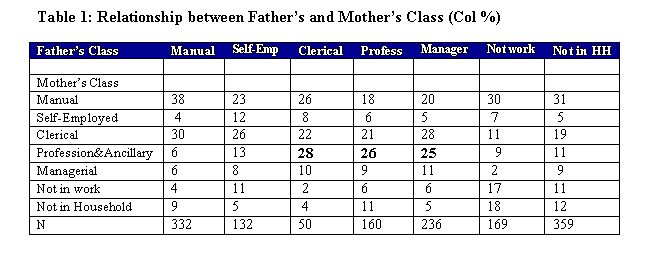
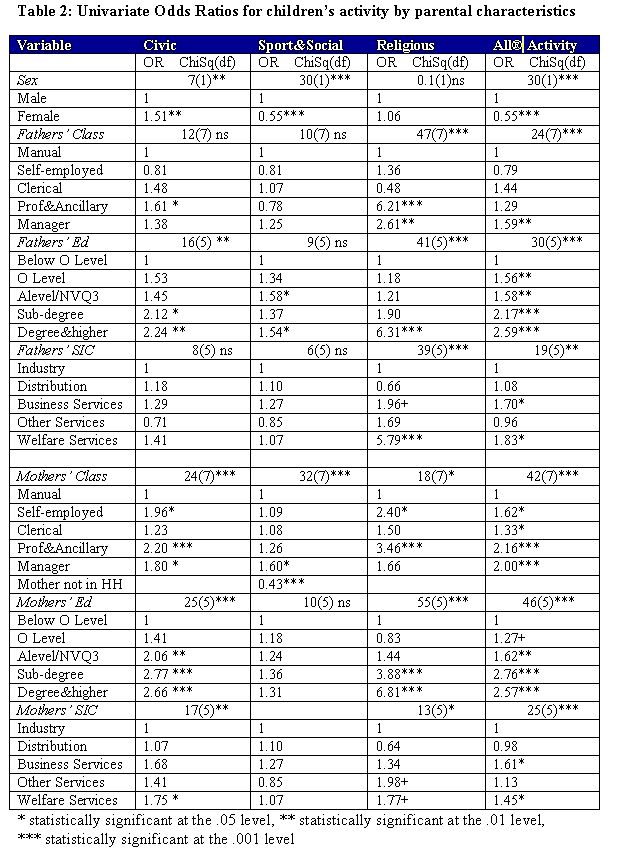
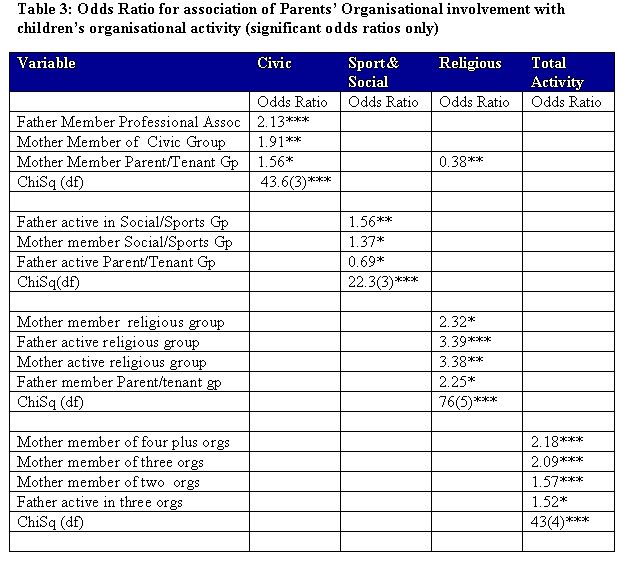
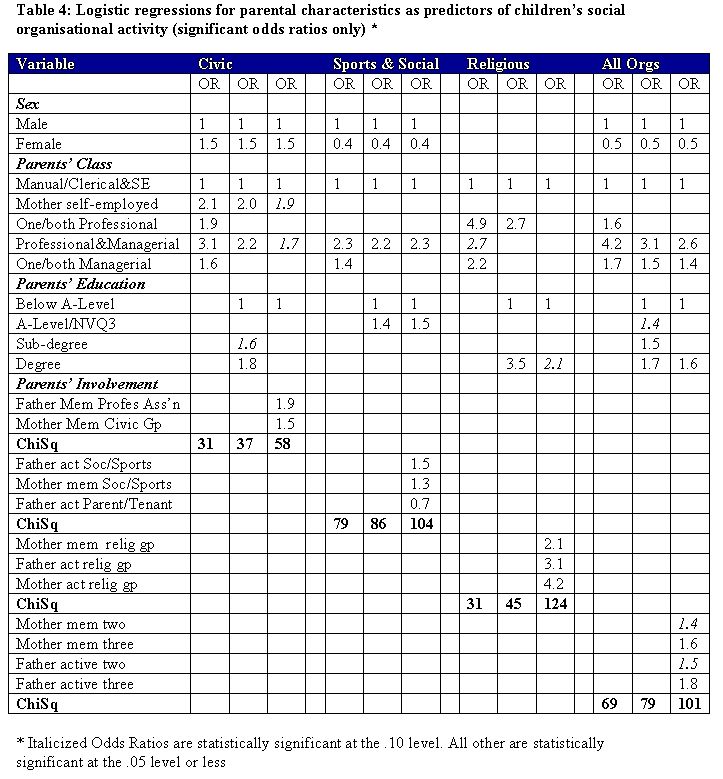
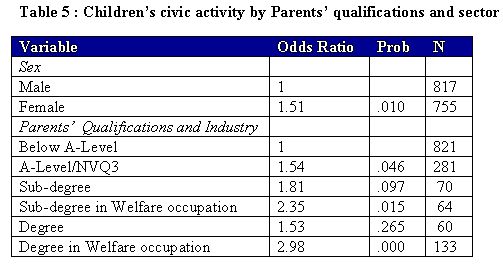
 Discussion
Discussion
 Notes
Notes2Membership/activity in any one year under- represents the links which people have with various social organisations over time. Warde et al (2001) and Savage et al (2002) show that most people have links into some social organisations and many people are potential recruits into particular organisations.
 Acknowledgements
Acknowledgements
ARCHER, M. S. 1979 Social Origins of Educational Systems, London:Sage.
BAGGULEY, P. 1995 'Middle-class radicalism revisited' in Tim Butler and Mike Savage (eds) Social Change and the Middle Classes, London: UCL Press.
BOURDIEU, P. 1997 'The Forms of Capital', from J.E. Richardson (ed.) Handbook of Theory of Research for the Sociology of Education (1986), reprinted in A.H.
Halsey, H. Lauder, P. Brown, and A.S. Wells (eds) Education, Culture, Economy, Society, Oxford: Oxford University Press. CORBY, S. and WHITE, G. 1999 'From New Right to New Labour' in (eds) Susan Corby and Geoff White Employee Relations in the Public Services, London: Routledge.
CROSSLEY, N. 2001 'New Social Movements, Higher Education and the Habitus: An investigation', Working Paper, University of Manchester.
Davidoff, L. and Hall, C. 1987 Family Fortunes: Men and Women of the English Middle Class 1780-1850, (5th edition) London: Routledge. DANIELSON, A. and SAVAGE, M. 'Cultural Capital and the Middle Class in Britain and Norway' paper presented at the British Sociological Association Conference, University of Manchester, April 2001.
EGERTON, Muriel and HALSEY, A.H., 1993 'Trends by Social Class and Gender in Access to Higher Education in Britain' Oxford Review of Education, 19(2):183-96.
EGERTON, Muriel forthcoming 'Higher Education and Civic Engagement' British Journal of Sociology, December 2002.
EMLER, N. 2000 'Social Structures and individual lives: effects of participation on the institutions of family, education and work' in J.Bynner and R.K. Silbereisen (eds) Adversity and challenge in life in the new Germany and in England, London: MacMillan.
EMLER, N. and FRASER, E. 1999 'Politics: the education effect', Oxford Review of Education, 25 (1&2): 251-72.
ERMISCH, J. and FRANCESCONI, M. 2002 Intergenerational Social Mobility and Assortative Mating in Britain, ISER Working Paper no 2002-6, Colchester: University of Essex, ISER.
GOLDTHORPE, J.H. (with C. Llewellyn and C. Payne) 1987 Social Mobility and Class Structure in Modern Britain (2nd Edition), Oxford:OUP.
GREEN, A. 1990 Education and State formation: the rise of education systems in England, France and the USA, London: MacMillan.
HALL, P 1999 'Social Capital in Britain', British Journal of Political Science, 29(3):417-61.
Halsey, A.H. 1992 Decline of Donnish Dominion, Oxford: Clarendon Press.
HEATH, A., JOWELL, R., CURTICE, J., EVANS, G. FIELD, J. and WITHERSPOON, S. 1991 Understanding Political Change: the British Voter 1964-1987, Oxford: Pergamon Press.
JOHNSTON, M. and JOWELL, R. 2001 'How robust is British civil society?' in (eds) Alison Park, John Curtice, Katarina Thomson, Lindsay Jarvis, Catherine Bromley British Social Attitudes: The 18th Report Public Policy, Social Ties, London: Sage
LOCKWOOD, D. 1996 'Civic Integration and class formation' British Journal of Sociology 47(3): 531-50.
LOCKWOOD, D. 1999 'Civic integration and social cohesion' in Ian Gough and Gunnar Olofsson (eds) Capitalism and Social Cohesion: Essays on Exclusion and integration, London: MacMillan.
Marshall, T.H. 1992 'Citizenship and Social Class' (first published 1950), reprinted in Tom Bottomore (ed.) Citizenship and Social Class, London: Pluto Press. MILLS, C. 1995 'Managerial and Professional Work Histories' in Tim Butler and Mike Savage (eds) Social Change and the Middle Classes, London: UCL Press.
NATHAN, G. 1999 A Review of Sample Attrition and Representativeness in Three Longitudinal Surveys, London: Government Statistical Services Methodology Series No. 13.
NIE, N.H., JUNN, J. and STEHLIK-BARRY, K. 1996 Education and Democratic Citizenship in America, Chicago: University of Chicago Press.
PUTNAM, R.D., LEONARDI, R., NANETTI, R.Y. 1993 Making Democracy Work: Civic Traditions in Modern Italy, Princeton, NJ: Princeton University Press.
PUTNAM, R.D. 2000 Bowling Alone: the collapse and revival of American community, New York: Simon and Schuster.
SAVAGE, M., BARLOW, J., DICKENS, P and FIELDING, T. 1992 Property, Bureaucracy and Culture: Middle-Class formation in contemporary Britain, London: Routledge.
SAVAGE, M. and LI, Y 2002 'Social Mobility, social capital and civic participation in England and Wales (1972-1998) Working Paper, Dept. Sociology, University of Manchester.
SAVAGE, M. WARDE, A., LONGHURST, B. and TOMLINSON, M. 2002 'Social Capital and Social Networks: the careers of political activists' ESRC End of Award Report, Swindon: ESRC.
SCOTT, J. 1991 'Networks of Corporate Power: A Comparative Assessment', Annual Review of Sociology, 17:181-203.
WALBY, Sylvia (2001) 'From Community to Coalition: the politics of recognition as the handmaiden of the politics of equality in an Era of Globalization' Theory, Culture & Society 18.
WARDE, A., TAMPUBOLON, G., TOMLINSON, M., RAY, K., LONGHURST, B. and SAVAGE, M. 2001 'Tendencies of Social Capital: Dynamics of Associational Membership', paper presented at the British Sociological Association Conference, University of Manchester, April 2001.
WOLF, A. 2002 Does Education Matter: myths about education and economic growth London: Penguin.